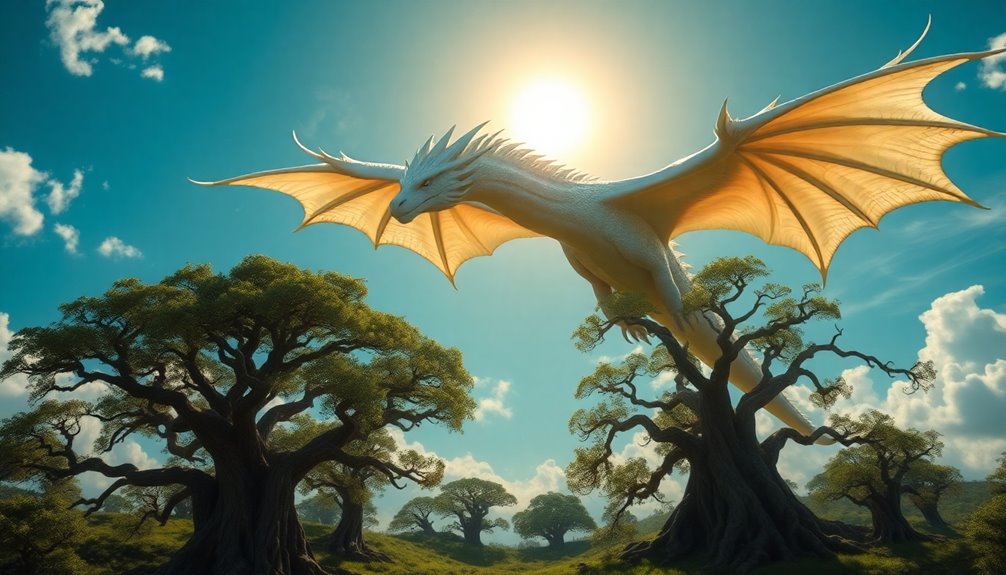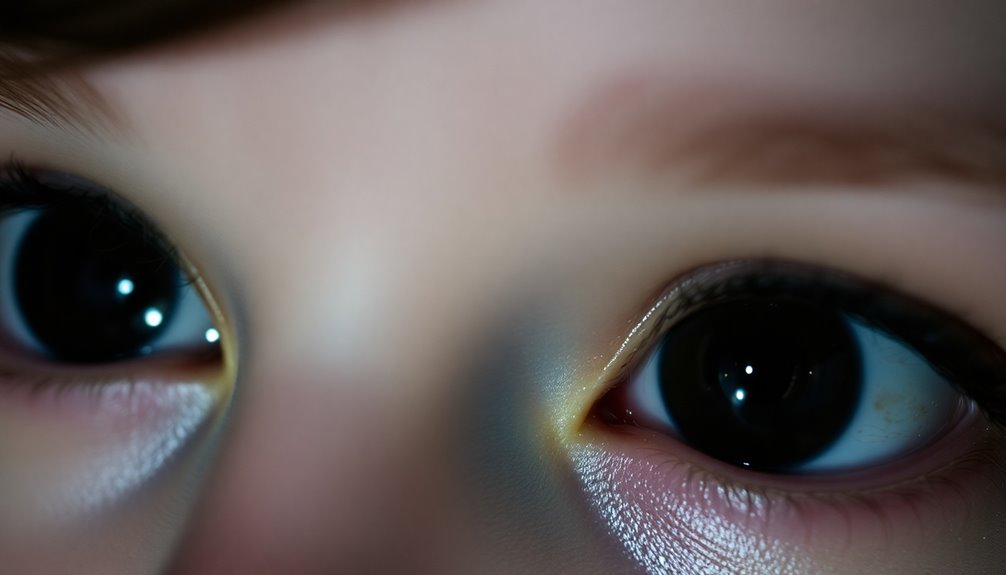White Dragons symbolize purity and serve as ethereal guardians, guiding you through mystical domains. They embody ideals of clarity and enlightenment, inspiring spiritual awakening and creative expression in your life. Their presence can enhance your artistic abilities, fostering emotional healing and collective growth. In various cultures, these dragons are revered for their auspicious nature, signifying good fortune and sacred knowledge. They promote connection and collaboration among like-minded individuals, igniting your creative passions. If you want to uncover more about their transformative powers and the magical energies they hold, there's a world waiting for you to explore.
Key Takeaways
- White Dragons symbolize purity and enlightenment, guiding individuals toward spiritual awakening and higher dimensions of consciousness.
- They embody ideals of divine mission and protection, serving as guardians of sacred knowledge and treasures across various cultures.
- In artistic realms, White Dragons inspire creativity and innovation, enhancing the artistic abilities of those who engage with their energies.
- They foster community connections and collaborations, nurturing shared experiences and supporting collective artistic expression among like-minded individuals.
- Unlike other dragons, White Dragons represent benevolence and auspiciousness, promoting emotional healing and personal transformation in spiritual journeys.
Origins of White Dragon Symbolism
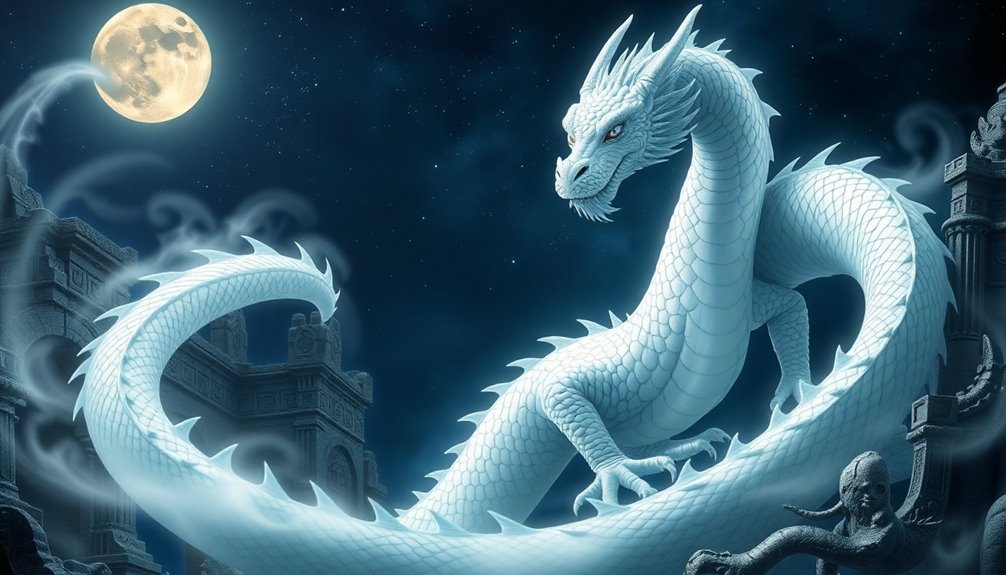
The origins of White Dragon symbolism can be traced back to its early use within the Heathen Movement, particularly by the White Dragon Kindred, which emerged before other groups like Wodens Folk. This symbol, crafted by a Scottish artist, features a dragon rampant and integrates colors from the English Cross Flag—red and white with a black outline.
The White Dragon embodies the ideals of purity and divine mission, linking it to the Sacred Blood Struggle and representing the White Race. Its historical connections to the Fylfot-Swastika highlight its association with stability and a return to the Golden Age, emphasizing the importance of ancient Aryan knowledge.
Additionally, the Nagas, connected to the White Dragon symbolism, are recognized as an Aryan race rich in magical knowledge. This connection roots the White Dragon deeper in cultural narratives, suggesting a profound spiritual significance that resonates through mystical domains.
As you explore this symbol, you're invited to appreciate its rich history and the powerful ideals it represents, serving as a guardian of purity and ancient wisdom.
Spiritual Significance and Attributes
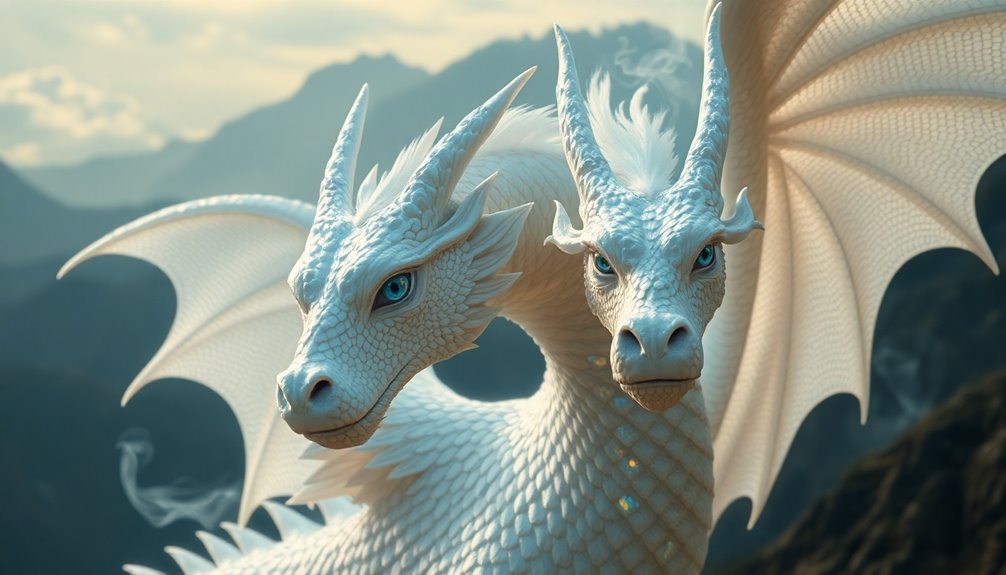
When you think of the White Dragon, consider how it embodies purity and enlightenment, guiding you toward spiritual awakening.
This powerful symbol inspires creativity and artistic expression, encouraging you to explore new domains of your imagination.
Purity and Enlightenment
Many believe that the White Dragon symbolizes purity and enlightenment, acting as a beacon for those seeking spiritual awakening.
This majestic creature embodies the essence of clarity, guiding you toward higher dimensions of consciousness. As you journey through your spiritual path, the White Dragon helps you integrate profound knowledge into your life.
You might find these attributes particularly inspiring:
- Purity: It represents the untainted essence of your true self.
- Enlightenment: The White Dragon illuminates your understanding of the universe.
- Spiritual Awakening: It encourages you to awaken to your higher purpose.
- Higher Dimensions: You can access deeper states of awareness with its guidance.
- Creative Energy: The White Dragon fuels your imagination and artistic expression.
Creativity and Artistic Expression
Harnessing the purity and enlightenment embodied by the White Dragon can considerably elevate your creativity and artistic expression. This mystical being inspires you to explore higher consciousness, merging spiritual elements to manifest innovative ideas across various mediums, like writing, art, and music.
When you connect with the energy of the White Dragon, you often experience a surge in your artistic abilities, tapping into your creative potential for the greater good.
The spiritual symbolism of the White Dragon promotes healing through creative expression, allowing you to channel your emotions and experiences into transformative artistic works. This process not only enriches your art but also fosters a deeper understanding of spiritual truths.
Many individuals who engage in daily creative practices inspired by the White Dragon report a significant increase in both the quality and quantity of their artistic output.
White Dragons in Mythology
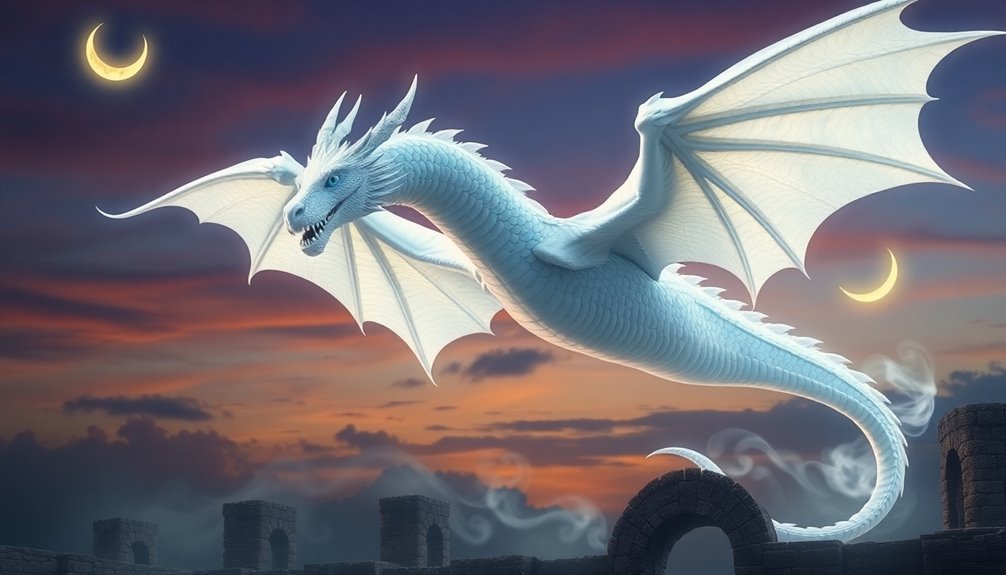
When you explore the mythology surrounding White Dragons, you'll find their cultural significance spans various civilizations.
These majestic beings embody symbolic attributes and powers that reflect purity, wisdom, and creativity.
Understanding their role in different mythologies can deepen your appreciation for their impact on spiritual practices and artistic expression.
Cultural Significance Across Civilizations
Throughout history, various civilizations have celebrated the White Dragon as a powerful symbol steeped in cultural significance.
These majestic beings represent not just strength but also a deep connection to spiritual awakening and the mystical domains. You'll find that different cultures have revered White Dragons for the roles they play in guiding and protecting individuals on their spiritual journeys.
Here are some key aspects of their cultural significance:
- In ancient Egypt, they symbolize purity and higher vibrational energies.
- In Celtic traditions, they inspire creative expression and enlightenment.
- Chinese culture views them as auspicious beings, bringing good fortune and prosperity.
- In Western mythology, they embody protection and the divine masculine.
- Across many civilizations, they serve as guardians of sacred knowledge and treasures.
The White Dragon's presence in art and spiritual practice illustrates their role as a bridge between humanity and the profound mysteries of existence.
Symbolic Attributes and Powers
White Dragons embody a range of symbolic attributes and powers that resonate across various mythologies. They symbolize purity and clarity, guiding you on your journey toward spiritual awakening.
These majestic beings are often associated with the element of water, representing creativity and artistic inspiration, which connects you to the Womb of Creation.
In their representation of infinity, White Dragons depict the interconnectedness of all life through the figure 8 pattern, reminding you of the cyclical nature of existence. As protectors and guardians, they provide healing energies that inspire you to express yourself artistically, fostering community and benefiting others.
The transformative power of White Dragons encourages personal growth and exploration. They guide you through challenges, helping to facilitate connections with higher dimensions of consciousness.
This connection can lead to profound insights and a deeper understanding of your place in the universe. By embracing the wisdom of White Dragons, you can enhance your journey toward self-discovery and spiritual fulfillment, releasing the potential that resides within you.
Their presence serves as a reminder that you're never alone in your quest for enlightenment and growth.
Artistic Inspiration and Creativity

- Embrace Spiritual Journeys: Encountering White Dragons during meditative practices can lead to transformative experiences.
- Enhance Your Skills: Many individuals report heightened artistic abilities after engaging with these divine energies.
- Boost Your Output: Daily writing and artistic practices often increase, fueled by the guidance of White Dragons.
- Foster Co-Creation: Collaborating with dragon energies emphasizes the importance of using art as a conduit for universal creativity.
- Explore New Ideas: The purity and clarity symbolized by White Dragons create a fertile ground for innovative projects.
- Cultivate Personal Growth: Engaging with the energies of White Dragons can aid in developing a growth mindset that promotes resilience and creativity in your artistic endeavors.
Healing Powers of White Dragons

Connecting with the ethereal energies of White Dragons offers not just artistic inspiration but also profound healing powers. Their unique energy resonates with higher vibrational frequencies, enabling transformative healing experiences that tap into your creative potential.
When you align with these majestic beings, you may find yourself inspired to express emotions through art, music, or writing, fostering spiritual wellness in your life.
The healing powers of White Dragons extend beyond individual benefits; they promote collective healing within Earth domains. This interconnectedness emphasizes the importance of co-creation between humans and dragon energies.
As you engage with their essence, you might experience a surge of gratitude and upliftment, facilitating personal growth and emotional healing.
Many individuals report enhanced creative abilities following their connection with White Dragons, as these powerful guides illuminate paths to artistic development.
Whether you seek to heal past wounds or elevate your spiritual journey, the presence of White Dragons can be a catalyst for profound transformation.
Embrace this opportunity to explore the healing powers they offer, and watch as your creative and spiritual worlds harmonize in beautiful ways.
Personal Transformations Through Encounter

When you encounter the White Dragon, you might find a surge of artistic guidance and inspiration flowing through you.
This transformative energy often opens up your creative potential, allowing you to express your healing journey through art, music, or writing.
Embracing this connection can empower you to navigate personal challenges and explore new avenues of self-discovery.
Artistic Guidance and Inspiration
As you commence your creative journey, encounters with White Dragons can serve as powerful catalysts for artistic guidance and inspiration.
These mystical beings often elevate your creative potential and skills, fostering profound spiritual connections. Many people report transformative experiences that uplift and nurture their artistic expressions.
You might find inspiration flowing through your music, art, and writing in ways you never expected. Consider how these aspects can open doors to new domains of creation:
- Uplifting Energy: White Dragons embody a nurturing presence that boosts your creativity.
- Spiritual Awakening: Encounters may lead you to discover deeper meanings in your work.
- Vibrational Creativity: They encourage exploration of higher artistic expressions.
- Co-Creation: Collaborating with dragon energies enhances your unique voice.
- Catalysts in Dreams: Visions of White Dragons can guide you on your creative path.
Embrace these encounters as they can help you navigate your journey of self-discovery.
The White Dragon's influence can illuminate your artistic pursuits, guiding you to express your innermost thoughts and emotions through various mediums.
Healing Through Creative Expression
Encounters with White Dragons can spark significant personal transformations, especially through creative expression. You may discover your inner strength while channeling the uplifting energies of these mystical beings. By engaging in healing through artistic endeavors, you tap into your creative potential, allowing your emotions to flow freely onto the canvas, page, or musical notes.
Many people report that their daily practices—be it writing, painting, or composing—are deeply inspired by the presence of White Dragons. This connection elevates your creativity, linking you to higher vibrational energies that promote clarity and inner wisdom during your artistic processes.
As you explore your creative journey, consider joining communities that celebrate White Dragon symbolism. Here, you'll find a network of individuals who share similar experiences, fostering collective artistic expression.
Collaborating with others amplifies your healing journey, as everyone contributes unique perspectives and energy, enriching the overall experience.
Embrace the transformative power of White Dragons, and let their influence guide your creative expression. You'll find that through art, you can heal not only yourself but also connect with others on a deeper level.
Community Connections and Collaborations
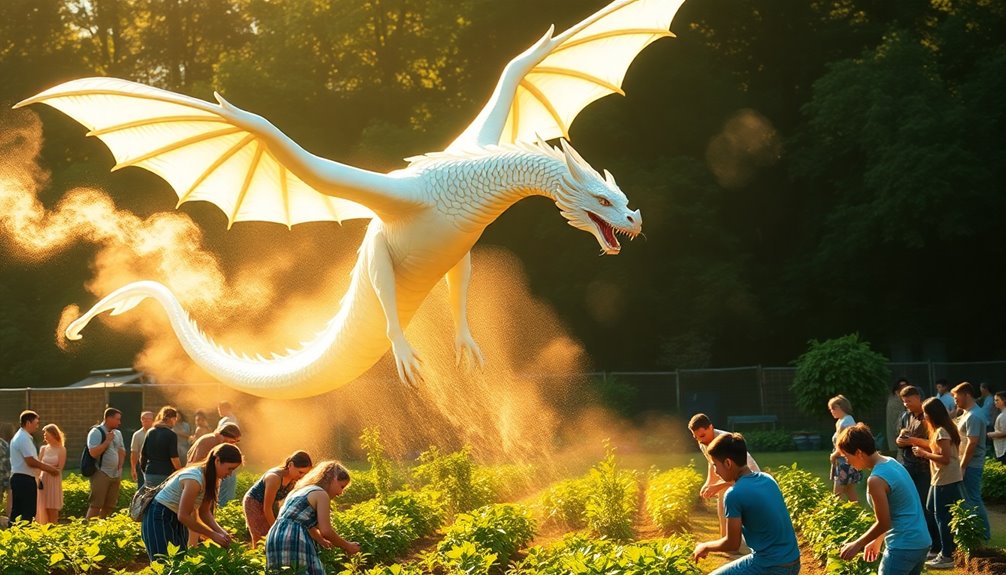
Connecting with White Dragon symbolism often leads to vibrant community collaborations that nurture creativity and spiritual growth. When you engage with the energies of the White Dragon, you'll discover a supportive environment that encourages artistic expression and personal development.
Here are some ways communities are embracing this powerful symbolism:
- Forming art groups that focus on White Dragons, fostering creativity and shared healing energies.
- Participating in online forums where members share their experiences and collaborate on projects.
- Attending workshops that explore integrating dragon symbolism into various art forms.
- Reporting feelings of gratitude and connection during communal activities, strengthening ties with others.
- Co-creating rituals that honor the White Dragon, blending personal experiences with cultural elements.
These initiatives not only enhance your artistic expression but also deepen your spiritual growth.
As you connect with likeminded individuals, you'll find your community thriving in the presence of White Dragon energies, allowing for transformative and enriching experiences.
Embrace these collaborations and watch as they elevate your creative journey while reinforcing the bonds that unite you all.
Rituals and Ceremonies Involving White Dragons

Many practitioners find that rituals and ceremonies involving White Dragons create powerful opportunities for inspiration and spiritual guidance. These rituals often begin with the creation of sacred spaces, where you can invoke the energy of the White Dragon to enhance your creativity.
Incorporating art, music, and writing, these ceremonies channel the healing energies of the White Dragons, promoting collective healing and encouraging higher vibrational creativity within the community.
During these gatherings, you might engage in meditative practices that connect you with White Dragon energies, facilitating personal transformation and enriching your artistic potential. Symbols like the figure 8, representing infinity, are commonly used to honor the White Dragon's connection to higher dimensions and spiritual enlightenment.
Community gatherings become vibrant celebrations of White Dragons, where you share experiences, stories, and artistic creations inspired by these mystical beings. This exchange not only strengthens your connection with the White Dragon but also fosters a sense of belonging among participants.
As you immerse yourself in these rituals and ceremonies, you'll likely discover new depths of creativity and spiritual insight, guided by the pure energy of the White Dragons.
Comparative Analysis With Other Dragons

Rituals centered around White Dragons highlight their unique qualities, especially when compared to other dragon symbols. The White Dragon stands as a beacon of purity and spiritual awakening, setting it apart from the more fiery and intense Red Dragon.
Here's a quick comparison to reflect on:
- White Dragon: Represents higher dimensions of consciousness and creative expression.
- Red Dragon: Embodies passion and primal energy, igniting transformation through resilience.
- Black Dragon: Symbolizes mystery and hidden wisdom, often seen as a protective force against the subconscious.
- Green Dragon: Emphasizes growth and harmony with nature, focusing on the nurturing aspects of life.
- Eastern vs. Western: Eastern dragons, like the White Dragon, are benevolent, while Western dragons, such as the Black Dragon, often take on adversarial roles.
This diversity in spiritual meanings showcases how each dragon contributes uniquely to transformation.
While the White Dragon guides you towards enlightenment, the Red Dragon fuels your creativity. Understanding these differences can deepen your appreciation for the intricate tapestry of dragon symbolism, allowing you to connect with the energies they represent in your own life.
Embracing the White Dragon Energy
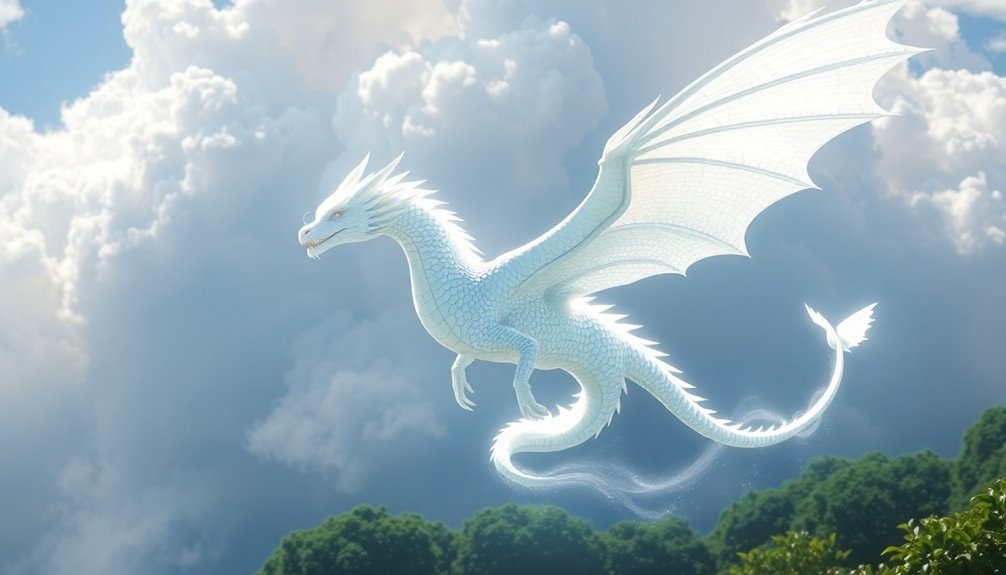
Embracing the energy of the White Dragon can transform your creative journey, inviting clarity and inspiration into your life. This powerful energy embodies purity and serves as a catalyst for spiritual awakening, helping you tap into your higher self.
When you connect with White Dragon energy, you'll find that your creative expression flourishes, enabling you to explore new artistic domains. The White Dragon symbolizes the Womb of Creation, merging spiritual elements to enhance your personal growth.
When you encounter this mystical being, you may experience uplifting moments that release your artistic potential, allowing you to express your innermost thoughts through art and writing. The tangible energy of the White Dragon promotes healing, offering you a supportive environment for your creative endeavors.
As you engage with others who share this connection, you'll find that community enhances collaboration and validates your feelings of belonging among those who recognize these mystical beings.
Embracing the White Dragon energy can lead to profound transformations in your life, igniting your passions and guiding you toward a fulfilling path of creativity and self-discovery.
Frequently Asked Questions
What Does the White Dragon Symbolize?
The White Dragon symbolizes purity, clarity, and spiritual awakening.
When you connect with this powerful creature, you tap into higher domains of consciousness and creative inspiration. It embodies the balance of Yin and Yang, serving as a protector on your spiritual journey.
You might find it encourages personal transformation and growth, guiding you toward artistic expression and healing.
Encounters with the White Dragon can uplift you, deepening your connection to your inner self and creative energies.
Who Is the White Dragon in Mythology?
Have you ever wondered who embodies wisdom and purity in mythology? The White Dragon appears in various cultures, often symbolizing strength, protection, and spiritual guidance.
In Eastern traditions, it represents the balance of Yin and Yang, while in other mythologies, it connects to divine creation and artistic inspiration.
This majestic creature serves as both a guardian and a muse, inspiring those who seek enlightenment and transformation in their lives.
What Does the Dragon Symbolize Spiritually?
In spiritual contexts, dragons often symbolize transformation, power, and wisdom. When you encounter a dragon in your journey, it's a call to embrace your inner strength and potential.
They represent the balance between chaos and order, urging you to face fears and grow. As you connect with this energy, you'll find inspiration and guidance, helping you navigate your path towards enlightenment and deeper self-discovery.
Trust in their protective presence as you evolve.
What Does the White Japanese Dragon Mean?
In Japanese culture, the White Dragon embodies purity, wisdom, and the spirit of water.
It represents good fortune, the control of rain, and the protection of sacred spaces.
When you think of this dragon, you see a guardian of harmony, a symbol of spiritual enlightenment, and a harbinger of peace.
Its presence reflects the importance of purity in both spirit and action, reminding you of the interconnectedness of nature and the mystical domains.
Conclusion
In embracing the white dragon energy, you tap into purity and protection, you foster creativity and inspiration, and you connect with your spiritual essence. By understanding its symbolism, you access healing powers and deepen your community ties. As you explore the rich tapestry of white dragon mythology, you'll find a guardian that encourages growth and transformation. So, let the white dragon guide you, empower you, and illuminate your path through the mystical domains of life!

